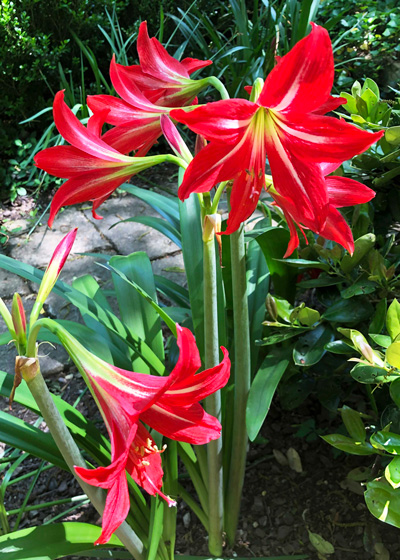St. Joseph’s Lily is Alive and Thriving

Every time we get record cold temperatures I worry about several plants in my North Texas gardens.

St. Joseph’s lily is near the top of that list. But it always seems to come back.
My history with this plant…
When I was a kid growing up in College Station most of the perennial plants we had in our gardens were “pass-along” plants. We only had one or two nurseries, and they dealt mainly with balled-and-burlapped arborvitae, junipers and shade trees. Perennials were pretty much out of their question. It was a different world back then.
For whatever the reason (probably slow propagation), this plant never hit the mainstream. Even to this day it’s still pretty much handed down from friend to friend, admirer to admirer, generation to generation. Web searches will occasionally pick up sources, especially if you search for it by its scientific name Hippeastrum x johnsonii.

What you’ll want to know about it…
Here are some facts I’ve thrown together to let you know more about this tough little beauty.
• St. Joseph’s lily is winter-hardy to USDA Hardiness Zone 7 (1990 map) and south all the way to the Gulf Coast.
• It does best in full sun or at least sun until early afternoon.
• Plant it in highly organic garden soil in a moist, well-draining location. Incorporate organic matter generously as you prepare the soil.
• Unlike many other bulbs, these don’t need to be planted deeply. Set them so their crowns extend up and out of the soil.
• Space the bulbs 12-14 inches apart so that they can develop into a solid planting.
• Leave them undisturbed for several years if you can for maximum display.
• Leave foliage intact after they finish blooming. It is attractive and will remain glossy and green long into the season as long as you don’t allow the plants to dry out. Yellowed or browned leaves can be trimmed off, as can spent flower stalks.
• When you decide to spread your planting to other beds or to share your plants with friends, dig and divide your plants in the fall. Replant them immediately and water them deeply right after planting. They will probably bloom some the following spring, but the showy displays will kick in the second spring.
Have fun. It’s a great plant with a rich history.
